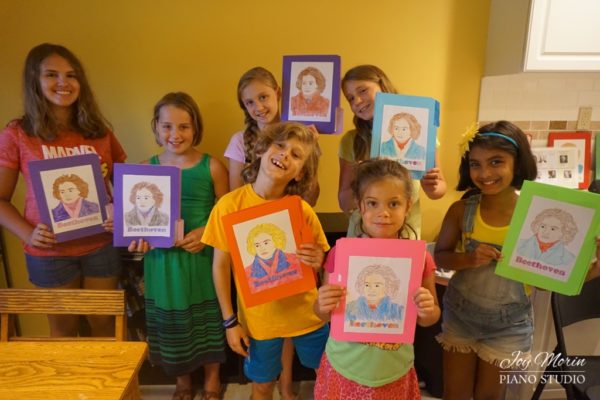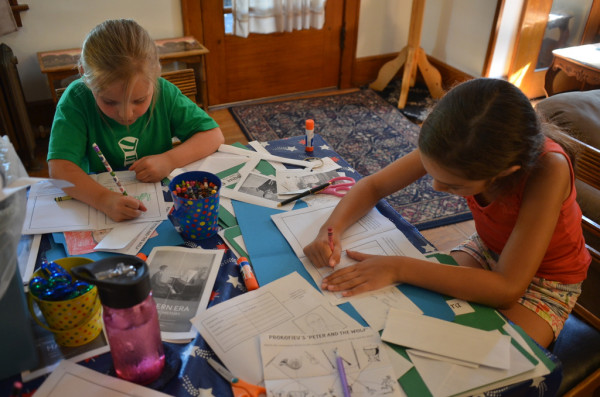
It’s March, and I have already had a couple of my piano students inquire whether I will be doing summer music camps again this year. The answer is YES, I have started thinking about them. 🙂
One of the camps from last year that I will definitely be repeating this summer is Music History Blast From The Past. I plan to use the same format as last year, but I will be focusing on different composers.
In case you are considering the possibility of offering a summer music camp or two, I thought I would share more about how I planned my music history camp last year.
I recommend group sizes of 3-8 students (5 or 6 is probably ideal). Students will be most comfortable working at a table; however, the floor is acceptable too. The lesson plans below are written for a 4-day camp that meets 2 hours each day; however, if you wish to incorporate other activities you can certainly change them. I do recommend planning on 20-30 minutes to study the musical time period, and an hour-and-a-half to complete the composer lapbook. If you wish to do a 5-day camp, a fun thing to do on the 5th day would be to have students present about the composers/time periods to the parents.

You will need to choose four composer lapbook pdfs from the ColorInMyPiano shop, selecting one composer from each of the periods of Music History: Baroque, Classical, Romantic, and Modern.
MATERIALS
- glue stick for each student
- scissors for each student
- colored file folder for each student
- printouts of the composer lapbook pdf for each student
- pencils
- crayons or colored pencils
OUTLINE FOR EACH DAY
0:00 On Day 1, ask each student to introduce themselves. On Day 2-4, begin the day by briefly reviewing the previous day’s material.
0:10 Study the time period of music history. There are a variety of resources online you can use. One is the free Music History Lapbook available at ColorInMyPiano.com: https://colorinmypiano.com/2012/08/24/freebie-music-history-periods-lapbook-study/. I found information about the development of the piano throughout history at the Piano Technicians Guild website (click “History” and look for the “Piano History Fact Sheet”).
0:30 Begin the composer lapbook. Show them your example of the lapbook. Hand out the file folders and the sheets with the composer picture and large pocket first, and give out the rest of the sheets as needed. As students cut, color, and glue, read the composer’s biography aloud to them. You can stop occasionally to play musical excerpts of the composer’s music, or you can play all the music at once after you read the biography.
1:00 Break
1:50 Continue and finish the composer lapbook. As students finish up, you can help them fill in any blanks inside the lapbook.
2:00 END
You can download a free PDF version of the information above on the Printables > Lesson Plans page.
 Music History Camp Lesson Plans (66.0 KiB, 8,821 hits)
Music History Camp Lesson Plans (66.0 KiB, 8,821 hits)
This simple camp format worked great. My private students have really benefitted from receiving an overview of the historical periods.
Offering summer camps is also a good way to augment your income during the summer months, too. Check out more photos from my Music History Camp last year here. And check out a variety of additional music history resources (mostly free!) to download here.


What age range of students would you suggest including in the camp?
My students last year ranged from 7 to 13 (all beginners or elementary students). A topic like music history allows for some range, I think (at least most than theory does).
I’m just curious…what do you usually charge for a Music History Camp? The same as a month’s worth of lessons? (since you’re meeting 4-5 days for longer time periods) I’m thinking of implementing this in my own studio this year, so I’d appreciate any helpful tidbits! 🙂
That’s one way to think of it, although I personally think that one-on-one contact time rightfully should cost a student more than if they are paying for a group setting like a camp. I would definitely research what other camps for kids cost in your area. Then consider how many hours you will spend planning for the camp, and what expenses you will need to purchase. Basically, you need to come up with a rate that is worth your time and effort!
Last year, I came up with summer packages for my private students to choose from. They had to pay their normal monthly tuition all summer either way, but could choose between having normal weekly lessons during June-August, or attending all 3 camps and scheduling 5 lessons as mutually convenient. Some students wanted regular weekly lessons, but bought one or two camps on top of that — which meant I actually made a little bit of extra money than usual during the summer months!
This is a great idea! I’m trying to organise regular group classes. In the summer I normally just give private lessons for the students who are still in town, but most of them travel (Delhi becomes unbearably hot, so I try to get out of here, too!)
It would be neat to have an excerpt page of popular pieces from each composer. Maybe just a melody line/simplified that each student can take home and play. For instance, Fur Elise. I sometimes have a movie time (with popcorn, of course) and show a film on a composer such as Beethoven….they love it!
Great idea! When I teach my lapbooks, I always send them home with a short piece by the composer at their playing level (if I can find one). I like your excerpt idea, though, too!
I love your lap books! This is the second year that I have used them for music camps with my cello students. I must admit that I tried to use it with 7-8 years old, and it was a little too heavy, so I revised & watered down quite a bit! Thanks for sharing these excellent ideas!